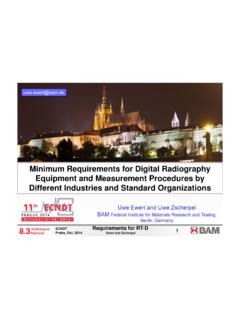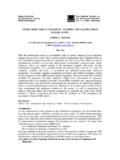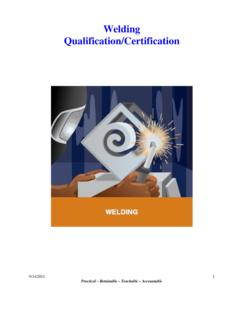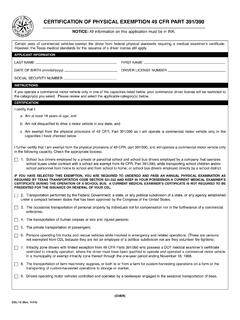Transcription of Comparison of Welding Inspector qualification or ...
1 Comparison of Welding Inspector qualification or certification schemes Dr. Konstantinos Krallis Consulting Engineer Fokionos Negri 82 GR-11361 Athens, Greece e-mail: 1. Abstract A number of reputable organizations worldwide operate different personnel qualification and/or certification schemes in the field of Welding Inspection, some of which are very popular. This paper contains a Comparison of the various schemes, their specific requirements, and their relation with other major national and international standards. It also investigates the possibility of an international standard on Welding inspection, which could serve as a global personnel certification scheme, suitable for ISO/IEC 17024 accreditation.
2 2. Introduction The American Welding Society (AWS) in the USA and The Welding Institute (TWI/CSWIP) in the UK introduced the first Welding Inspector personnel certification schemes in 1976. These schemes became widely accepted and were followed by similar schemes in Australia and South Africa, as well as a second scheme in the UK by BINDT/PCN. The International Institute of Welding (IIW) also provides a Welding Inspector qualification scheme. Calls for tenders for various international projects (pipelines, oil refineries) specify employment of Welding inspectors (WI) qualified and/or certified according to some scheme, implicitly excluding the others. 3. Purpose The original purpose of Welding Inspector qualification and/or certification1 schemes was to ensure a supply of shop level quality control personnel.
3 It was generally expected that Welding inspectors would come from the pool of welders and Welding machine operators. In addition, other categories of technical personnel in the field of manufacturing were certified. These include NDT inspectors, 2nd and 3rd part inspectors working for Inspection or Product Certification houses and managerial staff, especially at times when the qualifications of International Welding Engineer and European Welding Engineer could not be attained easily. The job outline of a Welding Inspection was also introduced in EN 719:1994, which defined it as examining, testing and measuring of Welding related matters . The definition was modified in ISO 14371 ( ), which contains a the globally accepted formal definition for Welding Inspection ( conformity evaluation of Welding -related matters by observation and judgement accompanied as appropriate by measurement or testing ) with the additional note that Welding inspection is a part of Welding coordination.
4 In addition, the tasks for Inspection 1 In this paper the term certification and (certification) scheme are used according to the relevant definitions in ISO/IEC 17024. qualification usually has a wider meaning. 1st International Conference on Welding & NDT, of HSNT and WGI Athens, Eugenides Foundation, 22-23 October 2018 More info about this article: testing before, during and after Welding are described in normative Annex B of ISO 14371 ( , and ). There is also reference in ISO 3834-5:2005, Annex A (informative): The minimum requirements for inspection personnel are stated in the following document: International Welding Inspection Personnel (IWIP) Doc.
5 IAB-041-2001/EWF-450. Personnel dealing with inspection fulfilling the requirements of these documents, or holding acceptable national qualifications, are considered to satisfy relevant requirements. While there are differences in the description of the roles and responsibilities and the levels of qualification /certification of a WI among the various schemes, there is a general agreement that the activities of the WI include: 1. Quality Control (QC) - Inspection: Basically direct visual inspection (VT), which is excluded from EN ISO 9712 certification. Some schemes include Radiographic Interpretation (RI). 2. Quality Assurance (QA): Most of the tasks and activities of the WI fall under QA. The WI is tasked to ensure that welders use the specified equipment and consumables, are properly qualified, follow approved procedures for preparation, Welding and post- Welding activities etc.
6 Therefore am extensive knowledge of relevant standards (ASME BPVC IX, ISO 15614, ISO 9606, etc) is essential. 3. Management: The WI is also tasked with some shop-level managerial tasks, like coordinating destructive and non-destructive testing activities, collecting and filling records etc. The extent of the managerial tasks depends on the business structure of the employer. 4. Welding Inspector qualification /certification schemes The AWS scheme This scheme for Certified Welding Inspectors (CWI) is described in documents AWS Specification for the qualification of Welding Inspectors and AWS QC1 Standard for AWS Certification of Welding Inspectors . Welding inspectors in this scheme are qualified in three levels (Associate CWI, WI and Senior CWI).
7 The AWS scheme is popular both in the USA and abroad. The TWI/CSWIP scheme This is a very popular British scheme, sponsored by the Welding Institute, also with three levels (Visual WI, WI, Senior WI). It is described in documents CSWIP-WI-6-92 and CSWIP-WI-1-91 and is accredited by UKAS under ISO/IEC 17024. In addition, TWI/CSWIP administers the specialized BGAS Welding Inspector scheme in cooperation with National Grid (UK). The BINDT/PCN scheme A quite similar scheme introduced by the British Institute of Non-Destructive Testing. It is quite similar to the CSWIP scheme, and its introduction caused a level of friction between the two organizations ( Welding and Joining Quality Board: Certification of Welding Inspectors , Connect, , July/August 2003, ) It is described in document PCN/WI/01 and is also accredited by UKAS under ISO/IEC 17024.
8 The IIW scheme The IIW Welding Inspector scheme, described in IAB-041, is a more comprehensive scheme and it is offered either as a stand-alone qualification or as an additional module to qualified International Welding Engineers and International Welding Technologists. While this scheme is also organized in three levels (Basic, Standard, Comprehensive), the requirements are higher than those of the AWS and CSWIP schemes. The IIW is also available under accredited certification in some countries. For example by CSWIP is accredited by UKAS also for the IIW scheme. The national WI schemes of Australia (WTIA) and South Africa (SAIW) follow the general layout of the IIW scheme. 5. Comparison of WI qualification certification schemes Appendix 1 contains three tables, where the requirements for access to each WI level are listed for four popular schemes (BINDT/PCN, TWI/CSWIP, AWS and IIW).
9 The requirements of the SAIW and WTIA schemes are not listed, but generally they are closer to those of the IIW scheme. It is obvious that there are considerable differences in the formal requirements (experience, training, exams). Based on comparisons like this, the WTIA in 2012 published a Guidance note on Comparison of Welding Inspector qualifications and certifications . An updated form of this table is included in Appendix B. WTIA used a four level structure to accommodate the three levels of all schemes, as the requirements of IIW/SAIW/WTIA are higher than those of AWS/CSWIP/PCN for the same formal level. 6. Is there need for an International Standard? The brief description of the WI qualification and/or certification schemes leads to the conclusion that, while they are geared towards the same job descriptions, they are not directly comparable.
10 In an international market, this may lead to difficulties, for example a contract may specify AWS/CSWIP, implicitly excluding personnel qualified under another scheme. Requirements of ISO 3834-5, with the option of acceptable national qualification , further confuse the situation. The scheme owners have tried for decades to offer easy access to their schemes to persons certified and/or qualified under another scheme. For example, TWI/CSWIP offers so-called Bridging Examinations for persons holding certifications by BGAS (both ways), AWS, WTIA, SAIW etc. BINDT/PCN also offered in the past a transition from BGAS WI to PCN Weld Inspector Level 2. These and other similar, exams, however, are not readily available when needed and they may be expensive.












